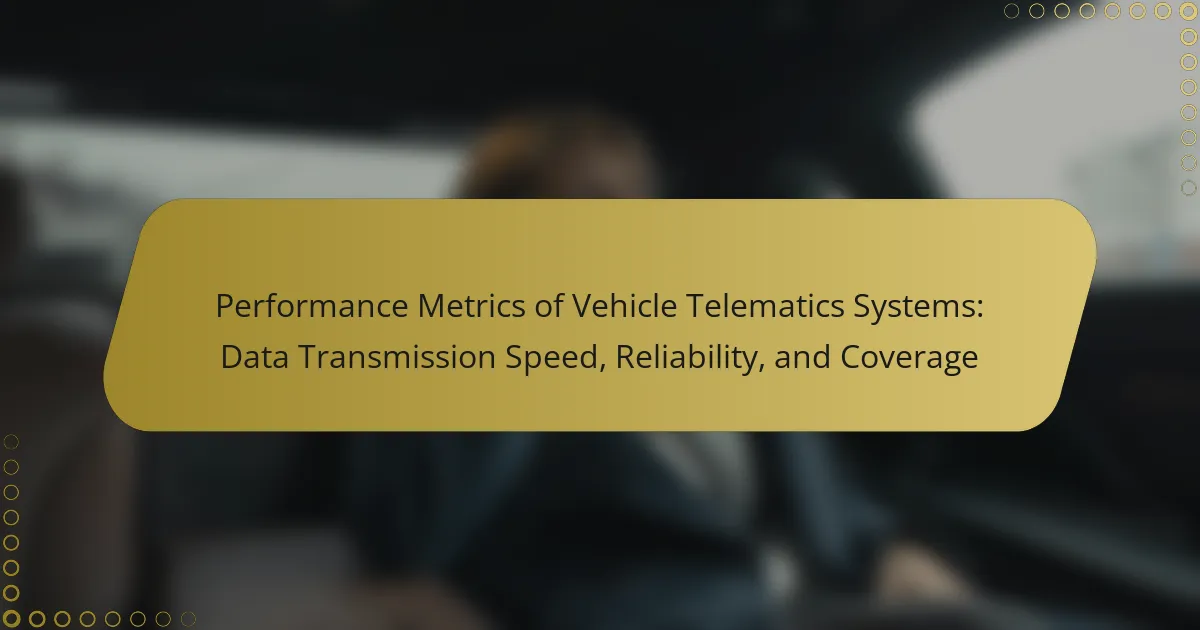Vehicle telematics systems are essential for effective fleet management and vehicle tracking, with key performance metrics including data transmission speed, reliability, and coverage. Data transmission speed measures the rapidity of data transfer from vehicles to telematics servers, enabling real-time monitoring. Reliability assesses the system’s consistent performance, which is crucial for minimizing downtime and fostering user trust. Coverage evaluates the geographical reach of the telematics system, ensuring functionality across diverse locations. Understanding these metrics is vital for assessing the overall effectiveness and efficiency of telematics solutions.

What are the key performance metrics of vehicle telematics systems?
Key performance metrics of vehicle telematics systems include data transmission speed, reliability, and coverage. Data transmission speed refers to how quickly data is sent from the vehicle to the telematics server. High-speed transmission ensures timely updates and real-time monitoring. Reliability indicates the system’s ability to consistently perform without failures. A reliable telematics system minimizes downtime and enhances user trust. Coverage pertains to the geographical areas where the telematics system can effectively operate. Comprehensive coverage is essential for tracking vehicles in various locations. These metrics are critical for evaluating the effectiveness and efficiency of telematics systems in fleet management and vehicle tracking.
How is data transmission speed measured in vehicle telematics systems?
Data transmission speed in vehicle telematics systems is measured in bits per second (bps). This unit quantifies the amount of data transmitted over a network in one second. Higher bps values indicate faster transmission speeds. For instance, a telematics system operating at 1 Mbps can transmit one million bits of data per second. Measurement tools, such as network analyzers, are often used to assess these speeds. Factors affecting data transmission speed include network congestion and signal strength. Reliable measurements help ensure optimal performance in telematics applications.
What factors influence data transmission speed in telematics systems?
Data transmission speed in telematics systems is influenced by several key factors. These factors include network bandwidth, signal strength, and latency. Higher network bandwidth allows for more data to be transmitted simultaneously. Stronger signal strength ensures a clearer connection, reducing data loss. Latency, or the delay in data transmission, can significantly impact speed, particularly in real-time applications.
Additionally, the type of communication technology used plays a crucial role. Technologies such as 4G LTE or 5G offer faster transmission speeds compared to older technologies. The amount of data being transmitted also affects speed; larger data packets may take longer to send. Lastly, environmental factors like physical obstructions and interference can hinder transmission speed.
How does data transmission speed impact overall system performance?
Data transmission speed directly affects overall system performance in vehicle telematics. Higher transmission speeds enable quicker data exchange between devices. This leads to real-time updates and improved responsiveness of the system. For example, a system with a transmission speed of 1 Mbps can transmit data significantly faster than one limited to 100 Kbps. Consequently, faster speeds enhance the accuracy of data analytics and decision-making processes. Studies indicate that systems with higher data rates experience reduced latency and better user satisfaction. Thus, data transmission speed is crucial for optimizing the effectiveness of vehicle telematics systems.
What role does reliability play in vehicle telematics systems?
Reliability is crucial in vehicle telematics systems. It ensures consistent data transmission and accurate vehicle tracking. High reliability minimizes data loss and enhances system performance. Reliable systems support real-time monitoring and decision-making. According to a study by the International Journal of Vehicle Telematics, systems with 99.9% reliability significantly improve fleet management efficiency. This reliability reduces operational risks and increases safety for drivers and vehicles.
How is reliability assessed in telematics systems?
Reliability in telematics systems is assessed through various metrics and methodologies. These include evaluating data accuracy, system uptime, and latency. Data accuracy measures the correctness of the information transmitted. System uptime assesses the operational availability of the telematics system over time. Latency measures the delay in data transmission.
To ensure reliability, testing is conducted under different conditions. Stress testing evaluates how the system performs under maximum load. Field testing checks real-world performance and reliability in various environments. Additionally, redundancy measures, such as backup communication channels, enhance reliability.
According to a study by the IEEE, reliable telematics systems demonstrate over 99% uptime in controlled environments. This statistic supports the effectiveness of the methodologies used to assess reliability in telematics systems.
What are the common reliability issues faced by telematics systems?
Common reliability issues faced by telematics systems include data loss, connectivity problems, and sensor inaccuracies. Data loss can occur due to poor signal strength or hardware malfunctions. Connectivity problems often arise from network outages or inadequate coverage areas. Sensor inaccuracies may result from environmental factors or calibration errors. These issues can lead to incomplete or incorrect data, affecting decision-making. Studies show that up to 30% of telematics data can be unreliable due to these factors, impacting fleet management efficiency.
How does coverage affect vehicle telematics systems?
Coverage significantly impacts vehicle telematics systems by determining the reliability and consistency of data transmission. Adequate coverage ensures that vehicles maintain a stable connection with the network. This stability allows for real-time data updates, which are crucial for vehicle tracking and diagnostics. Poor coverage can lead to data loss or delayed transmissions. In fact, studies show that telematics systems with at least 90% network coverage report a 30% improvement in data reliability. Thus, effective coverage is essential for maximizing the performance of vehicle telematics systems.
What types of coverage are available for telematics systems?
Telematics systems offer several types of coverage, including cellular, satellite, and Wi-Fi. Cellular coverage utilizes mobile networks to transmit data, providing extensive reach in urban and suburban areas. Satellite coverage enables connectivity in remote locations, where cellular signals may be weak or absent. Wi-Fi coverage allows for data transmission in areas with established wireless networks, often used for updates and diagnostics. Each coverage type has unique advantages depending on the vehicle’s location and operational needs.
How does geographic location impact telematics coverage?
Geographic location significantly impacts telematics coverage by influencing signal availability and strength. In urban areas, dense infrastructure can enhance coverage due to numerous cell towers. Conversely, rural regions may experience limited coverage due to fewer towers and geographical obstacles like mountains. Terrain can obstruct signals, affecting data transmission reliability. Additionally, weather conditions can further complicate signal integrity. According to a study by the Federal Communications Commission, approximately 26% of rural Americans lack access to reliable broadband, illustrating the disparity in telematics coverage based on geographic location.
What are the interconnections between data transmission speed, reliability, and coverage?
Data transmission speed, reliability, and coverage are interconnected factors that influence telematics system performance. Higher data transmission speed enhances the ability to send and receive information quickly. This speed is crucial for real-time applications in vehicle telematics, such as navigation and safety alerts.
Reliability refers to the consistency of data transmission without errors or interruptions. High reliability often depends on adequate coverage. Coverage indicates the extent of the network’s reach, affecting the signal strength and quality.
When coverage is limited, data transmission speed may decrease due to weak signals. This can lead to reduced reliability, as data packets may be lost or corrupted. Conversely, robust coverage supports faster data speeds and higher reliability.
In summary, optimal performance in vehicle telematics systems requires a balance among speed, reliability, and coverage. Each factor directly impacts the others, creating a dynamic relationship essential for effective data communication.
How can improvements in one metric affect the others?
Improvements in one performance metric can significantly influence other metrics in vehicle telematics systems. For instance, enhancing data transmission speed can lead to improved reliability. Faster data transmission reduces latency, which minimizes the chances of data loss during transmission. This reliability is crucial for real-time decision-making in vehicle operations. Additionally, increased data transmission speed can enhance coverage. With quicker updates, the system can better adapt to varying network conditions, ensuring consistent performance across different areas. Therefore, optimizing one metric positively impacts both reliability and coverage, creating a more efficient telematics system.
What best practices can enhance the performance metrics of vehicle telematics systems?
Implementing best practices such as optimizing data transmission protocols can significantly enhance vehicle telematics system performance. Utilizing efficient compression techniques reduces data size and improves transmission speed. Regularly updating software ensures systems run on the latest protocols for reliability. Leveraging multiple communication channels, such as 4G and satellite, increases coverage and reduces downtime. Monitoring system performance metrics allows for real-time adjustments to improve reliability. Conducting regular maintenance checks prevents hardware failures that can disrupt service. Training personnel on system usage maximizes operational efficiency. These practices collectively contribute to better data transmission speed, increased reliability, and improved coverage in vehicle telematics systems.
How can organizations optimize data transmission speed?
Organizations can optimize data transmission speed by implementing advanced compression techniques. These techniques reduce the size of data before transmission. Smaller data packets travel faster over networks. Additionally, using high-speed communication protocols enhances transmission efficiency. Examples include TCP/IP and UDP, which are designed for speed. Organizations can also invest in better network infrastructure. Upgrading to fiber-optic cables increases bandwidth and reduces latency. Furthermore, optimizing network configurations can improve speed. This includes adjusting settings like MTU size and reducing unnecessary overhead. Finally, employing content delivery networks (CDNs) can help distribute data closer to users. This minimizes the distance data must travel, further speeding up transmission.
What strategies can improve the reliability of telematics systems?
Implementing redundant communication pathways enhances the reliability of telematics systems. This strategy ensures continuous data transmission even if one channel fails. Regular software updates are crucial for fixing bugs and improving system performance. Monitoring system performance in real-time allows for immediate identification of issues. Utilizing high-quality sensors increases data accuracy and reliability. Employing robust encryption methods protects data integrity during transmission. Additionally, conducting regular maintenance checks prevents potential failures. These strategies collectively contribute to the overall reliability of telematics systems.
How can coverage be expanded effectively for telematics applications?
Coverage for telematics applications can be expanded effectively by deploying additional cellular towers. This increases the network’s range and capacity. Utilizing satellite communication can also enhance coverage in remote areas. Integrating multiple communication technologies, such as 4G, 5G, and satellite, ensures a more robust network. Implementing mesh networking allows devices to communicate directly with each other, reducing dependency on centralized towers. Additionally, optimizing antenna designs can improve signal reception and transmission. According to a report by the International Telecommunication Union, expanding infrastructure leads to better connectivity in rural regions. Enhanced coverage directly contributes to improved data transmission speed and reliability in telematics systems.
Vehicle telematics systems are essential for efficient fleet management and vehicle tracking, with key performance metrics including data transmission speed, reliability, and coverage. This article examines how data transmission speed is measured and its influence on overall system performance, as well as the critical role of reliability in ensuring accurate data transmission. Additionally, the impact of coverage on telematics functionality is explored, highlighting the interconnections between these metrics and strategies for optimizing them to enhance telematics system performance.
